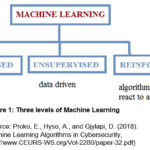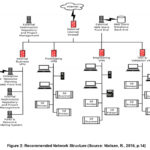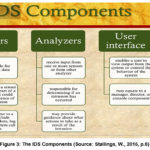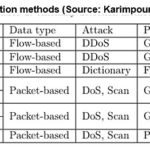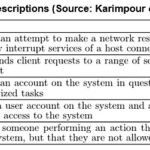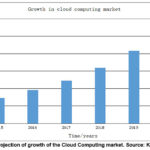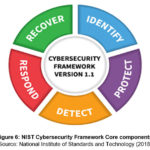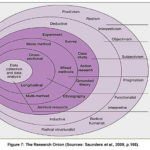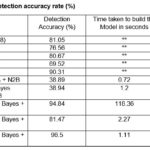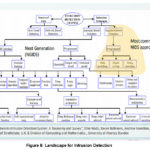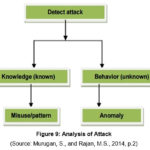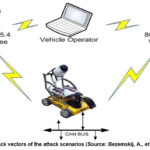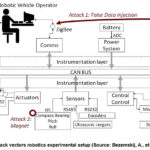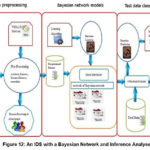Performance of Machine Learning and other Artificial Intelligence paradigms in Cybersecurity
Introduction
Background
Cyber security is the collection of policies, techniques, technologies, and processes that work together to protect the confifidentiality, integrity, and availability of computing resources, networks, software programs, and data from attack (Berman, D.S., et al., 2019). The process of instructing computers to learn is called machine learning. Machine learning (ML) algorithms inspired by the central nervous system are referred to as Artifificial neural networks (ANNs), and this involves programming computers to teach themselves from data instead of instructing them to perform specific tasks. Deep Learning (DL) is a special category of ML purposed to bring it to closer to Artificial Intelligence (AI). ML is known for automating the analysis of large data sets and producing models of the general relationships found among the data.
According to Truong, T.C., et al., (2020), the three classes of ML are as follows as illustrated on Figure 1 below:
- Supervised
learning: where training examples are given to the methods in the form of
inputs labeled with corresponding outputs;
- Unsupervised
learning: where unlabeled inputs are given to the methods;
- Reinforcement
learning: where data used is in the the form of sequences of actions,
observations, and rewards.
The
research is purposed to evaluate the performance of Machine Learning and other
Artificial Intellligence paradigms use in Cybsersecurity. The phenomenal growth
in the use of the internet and its associated threats have precipitated the
Network Intrusion Detection Systems (NIDS). The NIDS is a category of computer
software that monitors system behaviour with a view to ascertain anomalous
violation of security policies and distinguishes between the legitimate network
users from malicious ones (Bringas, P.B., and Santos, I., 2010, p.229).
NIDS
exist in two categories, anomaly detectors and misuse network detectors. Misuse
detection systems invigilate all incoming traffic to detect any sequence that
appears in that knowledge base. On the contrary, anomaly detection systems
focus on discovering new unknown threats (Bringas, P.B., and Santos, I., 2010,
p.229). Research conducted by Bringas and Santos (2010, p.229) on Artificial
Intelligence paradigms for use in network anaomaly detection focused on neural
networks, genetic algorithms, fuzzy logic, support-vector machines, finite
automata, and other diverse data-mining-based approaches.
Information
Systems Security (ISS) comprises computer security and communications security.
The normal requirement for network security is an Intrusion Detection
Systems(IDS) and Intrusion Prevention Systems (IPS). A firewall provides
network security against external threats in order to preserve sensitive files
on computers within the network (Stallings, W., 2015, p.10). Each of the
devices on the network can be thought of as a node; each node has a unique
address. The phenomenal growth of the use of wireless technology has increased
the vulnerability of networks (Stefanova, Z.S., 2018, p.2). Consequently, the
use of a firewall as one of the classical security measures has proved to be
inadequate. The cyber-criminals have now become innovative with their new
techniques.
Cybersecurity is purposed to protect internet-connected systems from cyberattacks. Gercke (2012) defined cybercrime as a computer related crime, and Oxford English Dictionary (2019) defined it as criminal activities carried out by means of computers or the internet. Governments, companies, organisation and individuals throughout the world are struggling to deal with cybercrimes, and the most forms of cyberattacks are ransomware, email phishing, cyber bullying, online extortions, etc (Yedaly, M., and Wright, B., 2016; Norton Symantec, 2017). Cybersecurity culture is defined as the beliefs, assumptions, attitudes, values, perceptions and knowledge that people have pertaining to cybersecurity and how these manifest in their interaction with ICTs (European Union Agency for Network and Information Security, 2017). Technology alone cannot be a cushion against cyber- threats, but instead humans should occupy a centre stage through cyber security culture (Gcaza et al., 2017). A strong cybersecurity culture changes the mindsets of people and their security behaviour (European Union Agency for Network and Information Security, 2017) and will stand as a human firewall against threats without coercion. The emergence of information and communication technologies (ICTs) has precipitated a dependent information society supportive of business management, information sharing and provision of electronic services (Malyuk and Miloslavskaya, 2016). In Africa, most organizations are not ready to respond to information security threats (Africa Cyber Security Report, 2016). These range from online visa applications to e-government platforms and this has made them prime targets for cyber-attacks (Africa Cyber Security Report, 2017). New technologies and business process automation is being done without ensuring that adequate security controls are put in place to safeguard these systems (Africa Cyber Security Report, 2016). There is a dire need to nurture an information society that exhibits a culture of respecting values, rights and freedoms in terms of accessing information so as to build confidence and trust in the use of ICTs in Africa (United Nations, 2014). In Africa, twenty-one countries have Data Protection Legislations and 13 have both Data and Cyber Security Legislation.
The
overall security in Cybersecurity is only as strong as the weakest link
(Nielsen, R., 2015, p.8). It is of primordial importance that the company
objectives clearly reflect access controls and security mechanisms. Common
practice shows that employees are given access to only what they need, the
internet is segregated into separate networks that compartmentalize security and
access privileges are limited to minimise any security breaches (Nielsen, R.,
2015, p.11). Nielsen (2015, p.12) argues that Virtual Private Networks or VPNs
are known to provide secure access to internal company internet by employees on
the Internet working from elsewhere outside the company premises. The
recommended network structure that provides a secure internet environment is
shown on Figure 2 below (Neilsen, R., 2015, p.14).
Convergence of wired and wireless services is dependent upon the progress made by the next-generation access networks. The broad-band evolution coupled with the phenomenal growth in the Internet has precipitated intense traffic patterns in access networks (Yu, J., et al., 2009, p.1). A unified networking platform for fixed and mobile users is now clothed with mobility features that deliver voice, data, and video services (Yu, J., et al., 2009, p.1).
The
first step in Network Security is to redirect all network traffic through a single point and
only open the ports on the firewall necessary for business traffic. This can be
strengthened by providing VPN support (Nielsen, R., 2015, p.18). Separation of
duties is one of the key principles of information security which can be
supported by authentication and authorization systems that give access only to
those business resources needed to perform one’s duties. As shown on Figure 1, this separation can be achieved
through VPNs. A VPN provides mobility to the users to work on-site or off-site.
However, in this separation of duties, there is need for an Intrusion Detection
Systems(IDS) and Intrusion Prevention Systems (IPS) that prevents the detected
attack from taking place and to protect the network (Nielsen, R., 2015, p.19).
The IDS often operates with sensors, analyzers and a user interface, as shown
Figure 3 below. A firewall provides network security against external threats
(Stallings, W., 2015, p.10). Operating
Systems Hardening is one of the basic steps to secure an operating system
(Stallings, W., 2015, p.28). This involves installing and patching the
operation system, and then hardening and/or configuring the operating system to
adequately provide acceptable security measures.
The phenomenal increase in internet-connected systems has precipiated an increase in the attack surface which has led to greater risk of cyber attack (Berman, D.S., et al., 2019). The cyber attacks are increasigly getting sophisticated with zero-day exploits and malware that evade security measures. Furthermore, commercial interest in cyber attacks has increased. We may need to leverage data analytics in cyber defense systems. Truong, T.C. (2020) observed that cybersecurity systems are increasingly getting used to improve operational efficiencies and reduce costs in critical areas, such as finance, transportation, defence, healthcare.
Statement of the Problem
The
phenomenal growth in the use of the internet and its associated threats have
precipitated the Network Intrusion Detection Systems (NIDS). The rapid growth
of the use of wireless technology has increased the vulnerability of networks.
Classical security measures have proved to be grossly inadequate under the
circumstances. The focus for Cybersecurity has now shifted to the use of
Artificial Intelligence paradigms for use in network anomaly detection such as
neural networks, genetic algorithms, fuzzy logic, support-vector machines,
finite automata, and other diverse data-mining-based approaches. The key
problem is to evaluate various Artificial Intelligence paradigms for use in
Cybersecurity in support of Bayesian Networks.
Purpose of Study
The
research is purposed to evaluate machine learning and other artificial
intelligence algorithms for use in Cybersecurity. .
Research Objectives
The
research objectives are to:
- Evaluate Artificial Intelligence
paradigms for use in network detection and prevention systems.
- Develop a Cybersecurity system that uses
artificial intelligence paradigms and can handle a high degree of complexity.
Research Questions
The
main research question was:
- Which
artificial intelligence paradigm is most effective in developing a Cybersecurity
system than can handle a higher degree of complexity?
The
sub questions are:
- How
are the Artificial Intelligence paradigms for use in network detection and
prevention systems ?
- How
is a Cybersecurity system developed that uses artificial intelligence paradigms
and can handle a high degree of complexity?
Literature
Review
Overview
Each of the devices on the network can be thought of as a node; each node has a unique address.The first step in Network Security is to redirect all network traffic through a single point and only open the ports on the firewall necessary for business traffic. Intrusion detection and prevention systems (IDPS) include all protective actions or identification of possible incidents, analysing log information of such incidents, how to block them in the beginning itself and generate reports for the concern of security personnel (Umamaheswari, K., and Sujatha, S., 2017, p.1). Stallings (2015, p.31-38) recommends the use of various security control measures in an organisation.
Network
attack detection is derived from network detection systems. From an analysis of
packet contents of the network, one can find the attacks or malicious behavior.
A general view of these intrusion detection methods are shown on Table 1 below.
The outcome of the research by Karimpour et al., (2016, p.4) showed various attack descriptions shown on Table 2.
AveW
= [ ΣN i=1 (Wi) – (ΣN i=1ExtWi) / N ]/N
The
research article by Demir and Dalkilic (2017) came out with a threat model
which assumed that there is a monitoring system that collects information on
the packet level. However, these assumptions may not always hold water.
According to Umamaheswari and Sujatha (2017), the components in IDPSs can be
sensors or agents, management and database servers, user and administrator
consoles for interaction and management networks. There is need for protection
of the software-based IDPS components such that their operating systems and
applications are kept fully up-to-date. Umamaheswari and Sujatha (2017)
proposed a model of defence framework which arranges intrusion detection
components in a maze-like structure so as to capture and dynamically correlate
unknown attacks as early as possible.
According
to Williams (2014), cyberspace is a human made information environment created
when computers and related telecommunication equipment and other components that
allow fast movement of large amounts of data are connected. The use of IP
addresses exposes the nonphysical nature of cyberspace. In the physical domain,
addresses reference a physical location but IP addresses tell the user where to
go, without necessarily pointing to a physical location. All the interconnected
devices and data that comprise cyberspace are manmade. Cyberspace is
categorized into three layers namely the physical layer, the logical layer and
the social layer.
The
Internet of Things (IoT) relates to interconnected devices via communication
channels and methods that transmit and communicate with each other. The
transmission method can be wired or wireless depending on the devices.
According to Symantec (2016), the Internet of Things is now a prime target for
hackers. Risks include data falsification, data manipulation, data and identity
theft or IP theft. The number of Internet of Things (IoT) devices is increasing
and those devices are being used every day (Concierge Security report,
2018).The Internet of Things (IoT) industry is expected to be worth $US19
trillion by 2020 globally (ACS, 2016). Furthermore, the growth in big data and
cloud computing industries also present great chances for the Internet of
Things (IoT) industry to flourish. However, cybersecurity is a key challenge in
the Internet of Things (IoT) realm. This is because hackers can penetrate an
organization’s network through the Internet of Things (IoT) devices (MacAfee,
2018) or through the cloud environment which the Internet of Things (IoT)
devices heavily rely on (KPMG, 2018).The security of those devices together
with the people that use them is very important as cybersecurity risk is high
(Concierge Security report, 2018).
According to Fehling et al., (2014), the cloud symbol is usually used to symbolize the internet. Cloud computing is now frequently used to describe the delivery of software, middleware platforms, infrastructure, whole business processes and storage services over the internet. These services are delivered when they are needed in the quantity needed at a certain time. Put differently, cloud computing is very much similar to the rent-a-car model. The cost effectiveness and efficiency of the cloud platforms is tempting most organizations to migrate to the cloud and enjoy a wide range of benefits (Sharma, 2012) which according to KPMG (2018) include:
- free
capital expenditure
- accessibility
from anywhere at anytime
- no
maintenance headaches
- improved
control over documents as files will be centrally managed
The
cloud computing market grew 4 times between 2015 and 2020 from US73 billion to
US270 billion as depicted on Figure 4 above (KPMG, 2018). Cybersecurity is also
a key challenge in this industry as cybercriminals use cloud services as
warehouses to store their malicious software and as targets that will be used
as launchpads for Denial of Service (DOS) attacks (MacAfee, 2018).
Cybercrime
has matured with a big market with several stakeholders and is unlikely to stop
as it is very rewarding. Online criminal marketplaces have gone to the extent
of selling ransomware services and products. End users of technology continue
to fail to adhere to basic security norms and this sustains the cybercrime
market (MacAfee, 2018). Cybercrime features on the top 10 global risks together
with terrorist attacks, natural disasters and extreme weather patterns KPMG
(2018). According to MacAfee (2014) and World Economic Forum (2017) as cited by
KPMG (2018), cybercrime costs the world $US 575 billion annually which
constitute 0.5% of the world’s Gross Domestic Product. The damage caused by
cybercrime is also expected to reach US$6 trillion by 2021 (KPMG, 2018).
Cybercrime is expected to grow taking advantage of poor security of the
Internet of Things (IoT) devices (MacAfee, 2018). Cybercriminals are also
riding on Artificial Intelligence (AI) to make and replicate malicious software
as well as identifying weak targets.
Table
3 below shows several forms of cybercrime and their associated estimated daily
activity.
Ransomware
erupted in 2015 and is likely to continue to be very popular going forward
whilst improving in sophistication. It is anticipated that businesses are going
to be facing ransomware attacks every 14 seconds by 2019 and the attacks on
healthcare systems is expected to quadruple by 2020 (Concierge Security report,
2018).
Figure
5 below shows the difference between
information security and cybersecurity. Information security culture consist of
perceptions, attitudes, assumptions, values and knowledge that guide the
interaction of people with organisational information assets with the mandate
of securing information (Al Hogail, 2015). On the other hand cyber security
culture is defined as the beliefs, assumptions, attitudes, values, perceptions
and knowledge that people have pertaining to cyber security and how these
manifest in their interaction with Information Communication Technologies
(European Union Agency for Network and Information Security, 2017).
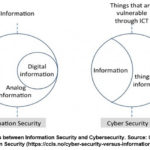 |
Figure 5: Differences between Information Security and Cybersecurity. Source: Center for Cyber and Information Security (https://ccis.no/cyber-security-versus-information-security/)
Click here to View figure
|
The NIST Cybersecurity Framework
According
to National Institute of Standards and Technology (2018), the NIST
Cybersecurity framework was crafted with the view of reducing cyber risk and
improve security to critical infrastructure. It is based on standards such as
Control Objectives for Information and Related Technologies (COBIT),
International Organization for Standardization (ISO) and International
Electrotechnical Commission (IEC). This framework is not a one size fits all
(Purdy, 2016) framework since different organizations face different
cybersecurity risks. The framework targets companies, Non-Governmental
Organizations, government agencies as well as communities regardless of their
size and focus. The framework consists of three main components which include
the framework core, implementation tiers and the framework profile.
The
NIST (2018) indicates that this component of the framework consists of five
sub- components or activities which are to identify, protect, detect, respond
and recover from cyber-attacks as shown below on Figure 6.
The framework core can also be viewed as a set of cybersecurity activities, desired outcomes and references applicable and common across all sectors. Each function has categories (total of 22) and subcategories (total of 98) (Angelini et al., 2017). Subcategories are basically practical activities that have to be done such as data collection on the organization’s software and hardware or even documenting legal requirements for cybersecurity (Angelini et al., 2017). Informative references are the international standards that are associated with each category and subcategory. The implementation of all the subcategories by an organization will result in a high cybersecurity level. However, it is important to note that the cybersecurity framework was primarily designed for critical infrastructure although it can be used by smaller companies and communities. According to Alcaraz and Zeadally (2015), critical infrastructure is made up of assets and systems which can be either virtual or physical that are so important to a nation such that any interruption of their services could have a serious impact on economic well-being, national security, public health or safety or a combination of all of these. Critical infrastructure includes power grids, hospital systems as well as public transportation.
Machine Learning
Computers have always operated on commands with a set of known responses programmed into them, with no room for deviation. Technology has developed to allow computers to learn new responses based on data they receive. This helps them complete tasks that were not originally programmed into them as they interact with their users. This technology is called Machine Learning and forms part of artificial intelligence (AI). In Machine Learning (ML) we focus on the computer programs that have access to large volumes of data from which they can learn by themselves. There are unlimited opportunities in ML for detecting network intrusion without using a signature database.
The use of AI and ML in Cybersecurity realises benefits which include faster response and protection, automated protection, learning to adapt to various challenging situations, personalization, and usabaility. The major applications of ML are as follows:
- Virtual Personal Assistants – Computing
smart devices are equipped with voice recognition applications that respond to
commands given by the user. In the beginning the responses are basic and at
times have errors. However, over time as the application develops the user’s
patterns and preferences, the responses become more complex and accurate.
Examples of such applications are Siri, Alexa, Google, etc., the more popular
virtual personal assistants that can be asked to recommend a good restaurant in
an area the user is visiting.
- Predictions while Commuting – Utilising
GPS navigation services, motorists can be advised by a machine learning
computer of the least congested or shortest to a predetermined destination.
Users seeking public transport, can book a taxi using an application of their
device. This application will search for the closest available taxi and provide
an estimated cost of the journey to the desired destination.
- Videos Surveillance – Artificial
intelligence is characterised by the ability to learn, comprehend and and
predict human behaviour. This assists users to prevent possible mishaps in
public areas.
- Social Media Services – ML is now being
utilized in targeting advertisements, personalization of news, and social media
platforms. In this way, ML enables online connection with people whose learning
profiles arae available on various platforms such as Facebook. Facial
recognition can also help identify the established connection of people from
pictures uploaded online.
- Email Spam and Malware Filtering – ML
can filter possible spam from email patterns of users and common recipients,
machine learning can filter possible spam. Also, by learning certain code, it
can detect different malware
- Customer Support Services – To reduce
the dependence on large number of call centre support agents, organisations are
utilising chatbots that respond to basic customer queries. With time they are
learning to respond to more complex questions as they continuously interact
with the clients with better answers.
- Search Engine Result Refining – The
manner in which users respond to a set of search results provide machine
learning with data to build a predictive pattern to improve future search
results. Google, Bing, etc., use such backend algorithms.
- Product Recommendations – ML is useful
in predicting and recommending the desired products to users on shopping
websites.
- Online Fraud Detection – Funds transfer
patterns are learnt by ML through determination of genuine and potentially
fraudulent online transactions.
Complexity
of cyber-physical systems
Cybercrimes
are monotonically increasing and there is a growing concern on the security,
confidentiality and computer assurance of the stored data. Intrusion detection
and prevention systems (IDPS) include all protective actions or identification
of possible incidents, analysing log information of such incidents, how to
block them in the beginning itself and generate reports for the concern of
security personnel (Umamaheswari, K., and Sujatha, S., 2017, p.1).
The complexity of cyber-physical systems (CPS), the roles and responsibilities of the humans that interact with them, and the cyber-security of these highly interconnected systems now requires a resilient CPS (Ghafouri, A., 2018, p.1). According to Ghafouri, resilient CPS provide interdisciplinary solutions for problems such as how to tailor the control system to enable it to respond to disturbances quickly and efficiently, how to better integrate widely distributed CPS to prevent faults that result in disruptions to operations of critical infrastructure, and how to design cyber-security protection mechanisms so that the system defends itself from cyber-attacks by changing its behaviors. Advanced control algorithms deployed in CPS are dependent upon data from multiple sensors to predict the behaviors of the system and make corrective responses. However, such systems can become brittle to the extent that any unrecognized fault or degradation in the sensors can lead to incorrect responses by the control algorithm and potentially compromise the desired operation. Ghafouri, A. (2018, p.1) argued that advanced control algorithms in resilient CPS require the implementation of detection and diagnosis architectures to recognize sensor faults and degradations.
A
significant challenge is the design of anomaly detectors that effectively
detect failures and cyber-attacks in CPS. In design and evaluation of anomaly
detectors, realistic attack models that represent the harmful effects of
cyber-attacks on CPS are needed (Ghafouri, A., 2018, p.2). Resilience in CPS is
defined as protecting the operational goals (e.g., stability) as well as other
non-operational goals (e.g., privacy) in the presence of both expected events
(e.g., failures) and unexpected events (e.g., cyber-attacks) (Ghafouri, A.,
2018, p.6). According to Ghafouri, A. (2018, p.6), resilience in CPS must
attain three goals:
- Integrity which represents the trustworthiness of data or resources,
- Availability which is the ability to access and use information on demand as specified, and
- Confidentiality, which is the ability to keep information secret or private from unauthorized users.
Research
Methodology
Presentation
of the methodology
The
Pragmatism paradigm which is intricately related to the Mixed Methods Research
(MMR) was used in this research. Pragmatism makes use of the rationale of the
congruence between knowledge and action. The Mixed Methods approach consisted
of a qualitative aspect whose research design was Focus Group discussions, and
the quantitative aspect whose research design was an Experiment.
A
research design symbolises advance planning or a research master plan (Kothari,
C.R., 2004). This planning caters for the research methods to be used,
techniques to analyse the data whilst addressing the objectives of the research
and taking into account the resources available. Research design is required
because it helps the smooth flow of the several research processes, thereby
making research efficient in getting more information with less investment in
time, effort and money (Kothari, C.R., 2004). The relationship between research
methodology and research design are amply illustrated by the research onion
shown on Figure 7 below.
With unsupervised classification, it is assumed that there is no external teacher that can train the classifier. The desirable position in cases of applications where the expected results are not known in advance is to train the classifier. In AI the algorithms can be improved by employing problem solving techniques used by human beings, such as learning, or gaining the ability to perform tasks from examples and training.
Qualitative
data for this research was collected on the cybersecurity framework and
industry practice. Focus Group discussions were held in order for the
participants to interact and share their experiences whilst influencing one
another’s views and contributions. The researcher facilitated the Focus Group
discussions on a Cybersecurity workshop with a total of 8 participants held at
the Harare International Conference Centre (HICC), on Thursday 7th and Friday
8th March, 2019.
The
first aim for analysis of qualitative data is to describe a phenomenon in some
or greater detail. According to Flick, U. (2013, p.7), the first approach in
the qualitative data analysis puts subjective experiences as the focus. A
second approach focuses on describing the making of a social situation. A third
approach is to go beyond the first two approaches and into spheres of implicit
and even unconscious aspects of a social phenomenon.
For the research to be credible special attention has to be paid to reliability and validity. Reliability measures consistency of the instrument in measuring. To test for reliability of the instrument, the Cronbach’s alpha coefficient was used to check for internal consistency. To be reliable the minimum threshold for the Cronbach’s alpha coefficient is 0.7 (Saunders et al., 2009). Reliability tests were conducted for the observation data and the key variables chosen.
There are two types of validity which are internal and external validity. Internal validity consists of face validity and construct validity. According to Saunders et al., (2009) reliability is the extent to which the techniques used for data collection and analysis could give the same results . It also concerns issues of whether same results would be found if the same study would be concluded by a different researcher or from a different observer. The other issue is whether there is transparency in the way raw data was analysed and processed to draw conclusions.
Possible Outcomes
The
expected accuracy rate for the research should be according to Table 4 below,
which shows the international benchmark.
Analysis
and Research Outcomes
The
landscape for intrusion detection is shown on Figure 8 below. It must be noted
that network traffic behaviour differs according to the service provision by
each specific equipment with a known IP address By using sensibility analysis
the knowledge representation model can be accomplished in order to avoid denial
of service attacks (Bringas, P.B., and Santos, I., 2010, p.242). The simple
rules for the analysis of attack are shown on Figure 9 below. An alarm is
triggered on the IDS in an anomaly-based intrusion detection if some type of
unusual behaviour occurs on the network.
The research by Napanda, K., et al., (2015) on the different Artificial Intelligence (AI) techniques highlighted the use of Machine Learning (ML), Neural Network and Fuzzy Logic to detect attacks on private networks. It must be noted that most of the Intrusion Detection Systems are signature based, and is it technically unfeasible to develop a perfect sophisticated Intrusion Detection System. An IDS can either be bifurcated as a Network IDS (NIDS) or as a Host IDS (HIDS). Network based IDS handles the analysis of the network traffic and distinguishes the unlicensed, illegitimate and anomalous behavior on the network. The IDS generally should capture packets traversing through the network using span port or network taps in order to detect and flag any suspicious activity (Napanda, K., et al., 2015, p.1). A device specific IDS effectively detects malicious activity or anomalous behavior on the specific device.
An
absolute cybersecurity remains a challenge these days of increasing Internet of
Things (IoT). The Intrusion Detection System (IDS) are known for observation of
the the network traffic, its analysis and identification of possible anomalies
or unauthorized access to the network behavior, with some of the IDS responding
to the intrusion to protect the computer network. However, there are several
limitations and problems of the existing methods (Stefanova, Z.S., 2018, p.1).
Arguably, there is a great challenge in providing a reliable way of protecting
the network system or to trust the IDS. Administrators are required to
regularly update their protection mechanisms in cases where specific weaknesses
and limitations of the system have been recognized by the intruder, therefore
challenging the detection system.
The
use of wireless technology is increasing the vulnerability of networks and
making them susceptible to cyber attacks (Stefanova, Z.S., 2018, p.2). The
classical security measures have been proved to be grossly inadequate. There is
need, therefore, to determine effective solutions for a dynamic and adaptive
network defence mechanism. Neural networks trained for a specific problem
domain can provide better solutions with the representative sets of training
data (Stefanova, Z.S., 2018, p.5). According to Stefanova, Z.S. (2018, p.5), a
majority of the IDS use ML classification problems solvable with supervised or
semi-supervised learning models. However, one major limitation of the work done
by Stefanova, Z.S. (2018, p.14) is on the analysis of the strategies and the
solutions of the players based on the informational structure in cybersecurity.
An autonomous robotic vehicles can be attractive targets for cyber attacks to prevent them from navigating and of completing the mission of intrusion prevention. The limitation of such detection is confined to knowledge-based and vehicle-specific methods, which are applicable to only specific known attacks ( Bezemskij, A., et al., 2017, p.1). The attack vectors of the attack scenarios used by Bezemskij, A., et al., (2017, p.2) is shown on Figure 10 below.
In
this experiment, the system is allowed to undertake several missions by the
robotic vehicle which is destined to reach on the ground with stochastic
elements that divert the robotic vehicle testbed. The practical experimental
setup for the attack vectors used is shown on Figure 11 below.
The methodology used by Bezemskij, A., et al., (2017, p.3) is a self-learning approach which generalizes the sensor data into signatures and uses these signatures as the data source’s unique description. Bezemskij, A., et al., (2017, p.5) presented a Bayesian network which can receives real-time information from a vehicle’s sensors, processes and communicates the modules in determining whether or not there is an attack. However, a limitation of this mechanism is its perfect performance only in low sampling frequency of one sample per second. A higher sampling frequency attracts lack of precise synchronisation between the heterogeneous data sources used..
Artificial Neural Networks (ANN) can be trained with the network traffic data to recognize the patterns in network data. Verification and distinguishing between intrusion and normal connections can be done by these neural patterns. An ANN transforms inputs to a set of searching outputs, through a set of simple processing units or nodes and connections between them (Sans Institute, 2011) (Alocious, C., et al., 2014, p.3). Two types of training algorithms called supervised learning and unsupervised learning, are used by the neural network based intrusion detection systems. The supervised learning state is learning the desired output for a given input. The Multilevel perception (MLP) is the most commonly used form of supervised learning algorithms. Unsupervised neural network learning algorithm, represented as self organized maps, learns without specifying the desired output. The Inference Analyser is used to produce an IDS with a Bayesian Network as shown on Figure 12 below.
Profiles of network software behaviour can be built with Neural Networks and distinguish between normal and anomalous/malicious software behavior (Napanda, K., et al., 2015, p.2). The use of Neural Networks in Intrusion Detection enables us to classify between malicious and safe networks. An ANN comprises processing units, nodes, and connections between them.
When solving complex problems one can use Fuzzy Logic which involves a fuzzy set of elements that can vary from 0 to 1 (Napanda, K., et al., 2015, p.3). However, unlike Boolean sets of ) and 1, there is no crisp value, although there is a perfect representation of the membership of the elements.
Machine Learning (ML), Neural
Network and Fuzzy Logic can
detect and prevent cyber attacks on private networks. The current
trend is to use Expert Systems, Neural Networks, Genetic Algorithms, Fuzzy Logic and others. Expert IDS can recognize and learn through patterns. According to Zekrifa, D.M.S. (2014,
p.15), most of the anomaly detection systems face a major challenge in the
great capability in detecting unknown or zero-day vulnerabilities where they
suffer from a major deficiency in their high false alarm rate. The two major
causes of the problem are that there is a lack of a training data set that
covers all the legitimate areas, and that abnormal behavior is not always an
indicator of intrusions.
Existing techniques for preventing intrusions often start with encryption and firewalls, then followed by Intrusion Detection System (IDS) technology can detect unauthorized access and abuse of computer systems from both internal users and external offenders (Tran, T.P., 2009, p.iv). Artificial Intelligence (AI) technologies such as Artificial Neural Networks (ANN) have been adopted to improve detection performance. The true power and advantage of ANN lie in its ability to represent both linear and non-linear underlying functions and learn these functions directly from the data being modeled. However, ANN is computationally expensive due to its demanding processing power, and so the network is unable to extrapolate accurately once the input is outside of the training data range (Tran, T.P., 2009, p.iv). These limitations challenge security systems with low detection rate, high false alarm rate and excessive computation cost. Tran, T.P. (2019) developed a novel Machine Learning (ML) algorithm to alleviate those difficulties of conventional detection techniques used in available IDS.
Table
5 below shows a comparison of the data mining techniques that can be used in intrusion
detection.
 |
Table 5: Advantages and disadvantages of data mining techniques (Source Almutairi, A. (2016) p.43)
Click here to View Table
|
The efficiency of data mining techniques ought to be optimized and enhanced in the quest for intrusion attack classification. Ajayi, A.
et al., (2013, p.239) evaluated the performance of the five popular data mining algorithms and these are Decision trees, Naïve bayes, Artificial neural network, K-nearest neighbor algorithm and Support vector machines. The pros and cons of each algorithm using the NSL-KDD dataset are shown on Table 6 below.
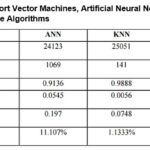 |
Table 6: Performance of Support Vector Machines, Artificial Neural Network, K-Nearest Neighbour, Naive-Bayes and Decision Tree Algorithms
Click here to View Table
|
An
intrusion detection system monitors computer systems and networks to determine
if a malicious event (i.e., an intrusion) has occurred, and each time a
malicious event is detected, the IDS raises an alert (Bolzoni, D., 2009, p.13).
Consequent to this, we can possibly get a true positive (TP), a false positive
(FP), a true negative (TN) or a false negative (FN) which occurs when no alert
is raised but a real intrusion attempt takes place. However, Bolzoni, D.,
(2009) addressed the problems of reducing false positives by allowing a user to
interact with the detection engine and raising classified alerts generated by
an Anomaly Based Signature (ABS). The advantages and disadvantages of ABSs and
SBSs are summarised on table, Table 7, below.
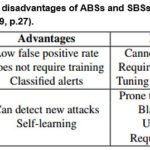 |
Table 7: Advantages and disadvantages of ABSs and SBSs models (Source: Bolzoni, D., 2009, p.27).
Click here to View Table
|
An
IDS must keep up with the amount of data and number of involved networking
components and devices that process the data. Developing a cloud-based
intrusion detection system requires additional requirements due to its complex
architecture and integrated services that interact together as well as with
outside services. According to Aljebreen, M.J. (2018, p.18), a cloud based
intrusion and detection system has the following minimum requirements:
- Handle large-scale, dynamic multi-tiered
autonomous computing and data processing environments
- Detect a variety of attacks with minimal
False Positive Rates
- Detect intrusions as they occur
- Self-Adaptive Autonomically, where the
CIDS should adapt to changes in configurations as the computing resources are
dynamically added and re?moved.
- CIDS Scalability which can handle a
large number of network nodes.
- Be deterministic, where the CIDS should
maintain the acceptable service?level agreement (SLA), be reliable, have high
uptime service as well as maintaining minimum overhead.
- Synchronize the autonomous CIDS, whereby
the collaborated intrusion detection systems must be synchronized in order to
detect attacks in real-time.
The
intrusion detection situation can be considered as a classification problem.
Challenges
and Future Direction
Cyber attacks are advancing rapidly and outpacing the technical measures in cybersecurity that deploy new signatures to detect these new attacks (Berman, D.S., et al., 2019). This challenging situation in combination with advances in machine learning (ML) presents unlimited opportunities to apply neural network-based deep learning (DL) approaches to cyber security applications to detect new variants of malware and zero-day attacks. The future direction of research in this area should the cascading connection of malicious activities throughout an attack lifecycle and the metrics for evaluation of DL performance. However, new datasets are required to develop new DL approaches for cybersecurity systems.
Conclusion
An
intrusion detection system monitors and determines whether or not a malicious
event has occurred, and raises an alert each time a malicious event is detected
(Bolzoni, D., 2009, p.13). The main research question was: Which artificial
intelligence paradigm is most effective in developing a Cybersecurity system
than can handle a higher degree of complexity? The first step in Network
Security is to redirect all network traffic through a single point and only
open the ports on the firewall necessary for business traffic. It must be noted
that network traffic behaviour differs according to the service provision by
each specific equipment with a known IP address.
Intrusion
detection and prevention systems (IDPS) include all protective actions or
identification of possible incidents, analysing log information of such
incidents, how to block them in the beginning itself and generate reports for
the concern of security personnel (Umamaheswari, K., and Sujatha, S., 2017,
p.1). The complexity of cyber-physical systems (CPS), the roles and
responsibilities of the humans that interact with them, and the cyber-security of
these highly interconnected systems now requires a resilient CPS (Ghafouri, A.,
2018, p.1). According to Ghafouri, resilient CPS provide interdisciplinary
solutions for problems such as how to tailor the control system to enable it to
respond to disturbances quickly and efficiently, how to better integrate widely
distributed CPS to prevent faults that result in disruptions to operations of
critical infrastructure, and how to design cyber-security protection mechanisms
so that the system defends itself from cyber-attacks by changing its behaviors.
The
Artificial Neural Networks (ANN) have been found to be quite effective,
especially when they use multilayer perceptrons, as was used by Aljebreen, M.J.
(2018, p.32) in intrusion detection. The multilayer perceptron learns the model
from the training data using an algorithm called backpropagation. The Error
data at the output layer is back propagated to earlier ones, which allows
incoming weights to these layers to be updated.
Acknowledgement
I
deeply appreciate the Atlantic International University for supporting this
research work as part of my Doctor of Science degree in Computer Science.
Funding
The
author(s) received no financial support for the research, authorship, and/or
publication of this article.
Conflict
of Interest
There
is no conflict of interest associated with this publication.
References
- ACS, (2016).Cybersecurity: Opportunities, Threats and Challenges.
- AFRICA Cybersecurity Report, (2016).
- https://www.serianu.com/downloads/AfricaCyberSecurityReport2016.pdf
- AJAYI, A., Idowu, S.A., and Anyahie, A.A., (2013). Comparative Study of Selected Data Mining Algorithms Used For Intrusion Detection, International Journal of Soft Computing and Engineering (IJSCE), ISSN: 2231-2307, Volume-3, Issue-3, July 2013, p.237-241.
- ALJEBREEN, M.J., (2018). Towards Intelligent Intrusion Detection Systems for Cloud Computing, Ph.D. Dissertation, Florida Institute of Technology, 2018.
- ALMUTAIRI, A., (2016). Improving intrusion detection systems using data mining techniques, Ph.D Thesis, Loughborough University, 2016.
- ALOCIOUS, C., Abouzakar, N., Xiao, H, and Christianson, B., (2014), Intrusion Detection Framework for Cyber Crimes using Bayesian Network, https://www.researchgate.net/publication/272999966_Intrusion_Detection_Framework_for_Cyber_Crimes_using_Bayesian_Network
- AL HOGAIL, M., (2015). How is the ministry fostering public-private partnerships (PPPs) with local private developers?, https://oxfordbusinessgroup.com/interview/right-home-obg-talks-majed-al-hogail-minister-housing
- ANGELINI et al., (2017).CRUMBS: a Cybersecurity Framework Browser.
- APRUZZESE, G; Colajanni, M.; Ferretti, L.; Guido, A.; & Marchetti, M.( 2018). “On the effectiveness of machine and deep learning for cyber security,” 2018 10th International Conference on Cyber Conflict (CyCon), Tallinn, 2018, pp. 371390.
- AZZALINI, A., and Scarpa, B., (2012), Data analysis and data mining : an Introduction, Oxford University Press, Inc., ISBN 978-0-19-976710-6.
- BERMAN, D.S., Buczak, A.L., Chavis, J.S., and Corbett, C.L. (2019). “Survey of Deep Learning Methods for Cyber Security”, Information 2019, 10, 122; doi:10.3390/info10040122
- BEZEMSKIJ, A., Loukas, G., Gan, D., and Anthony, R.J., (2017). Detecting cyber-physical threats in an autonomous robotic vehicle using Bayesian Networks, 2017 IEEE International Conference on Internet of Things (iThings) and IEEE Green Computing and Communications (GreenCom) and IEEE Cyber, Physical and Social Computing (CPSCom) and IEEE Smart Data (SmartData), 21-23 June 2017, IEEE, United Kingdom, https://ieeexplore.ieee.org/document/8276737
- BOLZONI, D., (2009). Revisiting Anomaly-based Network Intrusion Detection Systems, Ph.D Thesis, University of Twente, The Netherlands, ISBN: 978-90-365-2853-5, ISSN: 1381-3617, DOI: 10.3990/1.9789036528535,
- BRINGAS, P.B., and Santos, I., (2010). Bayesian Networks for Network Intrusion Detection, Bayesian Network, Ahmed Rebai (Ed.), ISBN: 978-953-307-124-4, InTech, Available from: http://www.intechopen.com/books/bayesian-network/bayesian-networks-for-network-intrusion-detection
- CONCIERGE, (2018). Concierge Security Report. Cybersecurity: Trends from 2017 and Predictions for 2018.
- CORNMEN, T.H, Leiserson, C.E, Rivest, A.L, Stein, C. (2009). 3rd ed. Introduction to Algorithms. Cambridge: MIT Press.
- CREWELL, J.W., (2014). Research Design: Qualitative, quantitative and mixed methods .4rd edition, Sage Publications,Inc.
- DEMIR, N., and Dalkilic, G., (2017). Modified stacking ensemble approach to detect network intrusion, Turkish Journal of Electrical Engineering & Computer Sciences, Accepted/Published Online: 15.11.2017, http://journals.tubitak.gov.tr/elektrik/
- EUROPEAN Union Agency for Network and Information Society (2017)
- https://openarchive.cbs.dk/bitstream/handle/10398/9524/EvaluationofENISA-
- FinalReport.pdf?sequence=1
- FEHLING, C., Leymann, F., Retter, R., Schupeck, W., Arbitter, P. (2014). Cloud Computing Patterns. Fundamentals to Design, Build, and Manage Cloud Applications. Springer-Verlag Wien .
- FLICK, U., (2013). The SAGE Handbook of Qualitative Data Analysis: Mapping the Field, New York, 2013.
- GCAZA, N., Solms, R. Von, & Vuuren, J. Van. (2015). An Ontology for a National CyberSecurity Culture Environment. In Proceedings of the Ninth International Symposium on Human Aspects of Information Security & Assurance (HAISA 2015) (1-10).
- GERCKE, M. (2012). ‘Cybercrime Understanding Cybercrime’, Understanding cybercrime: phenomena, challenges and legal response.
- GHAFOURI, A., (2018). Resilient Anomaly Detection in Cyber-Physical Systems, Ph.D. Dissertation, Faculty of the Graduate School of Vanderbilt University, February 2018.
- KARIMPOUR, J., Lotfi, S., and Siahmarzkooh, A.T., (2016). Intrusion detection in network flows based on an optimized clustering criterion, Turkish Journal of Electrical Engineering & Computer Sciences, Accepted/Published Online: 17.07.2016, http://journals.tubitak.gov.tr/elektrik
- KOTHARI, C., (2004). Research Methodology Methods and Techniques, 2nd Edition. New Age International Publishers.
- KPMG, (2018).Clarity on Cybersecurity. Driving growth with confidence.
- MacAfee, (2018).
- https://www.mcafee.com/consumer/en-sg/store/m0/catalog.html
- MALYUK and Miloslavskaya, (2016). Cybersecurity Culture as an Element of IT Professional Training, TBA.
- MURUGAN, S., and Rajan, M.S., (2014). Detecting Anomaly IDS in Network using Bayesian Network, IOSR Journal of Computer Engineering (IOSR-JCE), e-ISSN: 2278-0661, p- ISSN: 2278-8727, Volume 16, Issue 1, Ver. III (Jan. 2014), PP 01-07, www.iosrjournals.org
- NATIONAL Institute of Standards and Technology, (2018). Framework for Improving Critical Infrastructure Cybersecurity Version 1.1.
- NAPANDA, K., Shah, H., and Kurup, L., (2015). Artificial Intelligence Techniques for Network Intrusion Detection, International Journal of Engineering Research & Technology (IJERT), ISSN: 2278-0181, IJERTV4IS110283 www.ijert.org, Vol. 4 Issue 11, November-2015.
- NIELSEN, R. (2015). CS651 Computer Systems Security Foundations 3d Imagination Cyber Security Management Plan, Technical Report January 2015, Los Alamos National Laboratory, USA.
- NORTON Symantec (2017) ‘2017 Norton Cyber Security Insights Report – Global Results’, p. 2018.
- OXFORD English Dictionary (2019). Oxford: Oxford University Press. Available at: https://en.oxforddictionaries.com.
- SAUNDERS, M.N.K., Thornhill, A., and Lewis, P., (2009). Research Methods for Business Students (5th Edition),Publisher: Pearson; ISBN-13: 978-0273716860, ISBN-10: 0273716867, https://www.amazon.com/Research-Methods-Business-Students-5th/dp/0273716867
- STEFANOVA, Z.S., (2018). “Machine Learning Methods for Network Intrusion Detection and Intrusion Prevention Systems”, Graduate Theses and Dissertations, 2018, https://scholarcommons.usf.edu/etd/7367
- SHARMA, R. (2012). Study of Latest Emerging Trends on Cybersecurity and its Challenges to Society. International Journal of Scientific and Engineering Research .Vol 3 Issue 6, June 2012.
- STALLINGS, W., (2015). Operating System Stability. Accessed on 27th March, 2019. https://www.unf.edu/public/cop4610/ree/Notes/PPT/PPT8E/CH15-OS8e.pdf
- SYMANTEC Annual Report (2016), https://s1.q4cdn.com/doc_financials
- TRAN, T.M., Ko, D.W., Ryul, C., and Dinh, H., (2019). A bayesian network analysis of reforestation decisions by rural mountain communities in Vietnam, Forest Science and Technology, DOI: 10.1080/21580103.2019.1581665.
- TRAN, T.P., (2009). Innovative machine learning techniques for security detection problems, Ph.D. Dissertation, University of Technology, Sydney, Australia, 2009.
- TRUONG, T.C; Diep, Q.B.; & Zelinka, I. (2020). Artificial Intelligence in the Cyber Domain: Offense and Defense. Symmetry 2020, 12, 410.
- UMAMAHESWARI, K., and Sujatha, S., (2017). Impregnable Defence Architecture using Dynamic Correlation-based Graded Intrusion Detection System for Cloud, Defence Science Journal, Vol. 67, No. 6, November 2017, pp. 645-653, DOI : 10.14429/dsj.67.11118.
- UNITED Nations Economic Commission for Africa. (2014).Tackling the challenges of cybersecurity in Africa.
- YEDALY, M. and Wright, B. (2016) ‘Cyber Crime & Cyber Security Trends in Africa’, Symantec.
- YU, J., Chang, G.K., Kooning, A.M.J, and Ellinas, G., (2009). Radio-over-optical-fiber Networks: Introduction to the feature issue, Journal of Optical Networking, Vol. 8, No. 5, May 2009.
- WILLIAMS, B. T., (2014). The joint force commander’s guide to cyberspace operations. Joint Force Quarterly, 73(2), 12–19. Retrieved from http://ndupress.ndu.edu/ Portals/68/Documents/jfq/jfq-73/jfq-73_12-19_Williams.pdf.
- ZEKRIFA, D.M.S., (2014). Hybrid Intrusion Detection System, Ph.D Thesis in Computer Science, School of Information Technology & Mathematical Sciences, 2014, University of South Australia, https://tel.archives-ouvertes.fr/tel-01584217

This work is licensed under a Creative Commons Attribution 4.0 International License.

